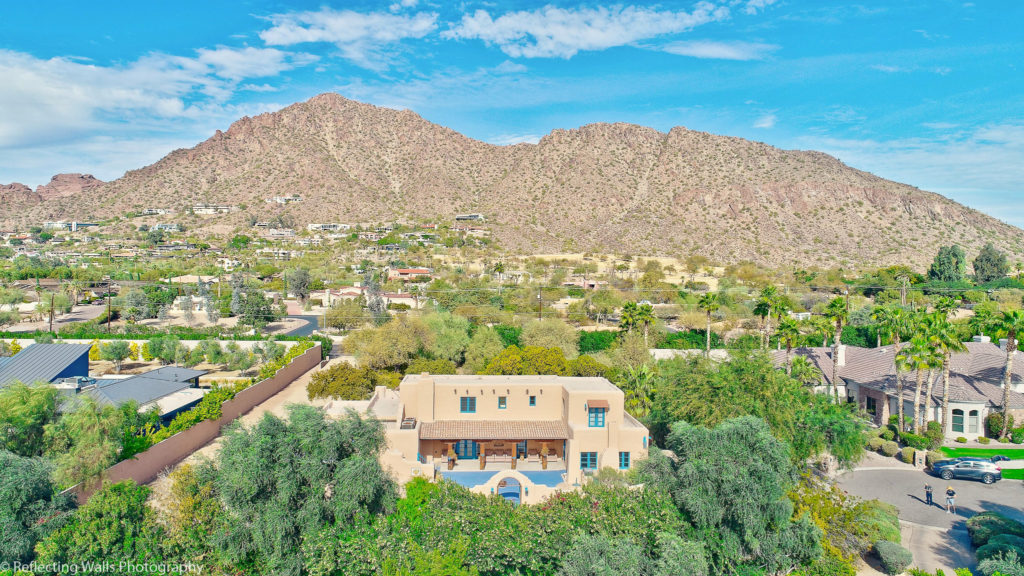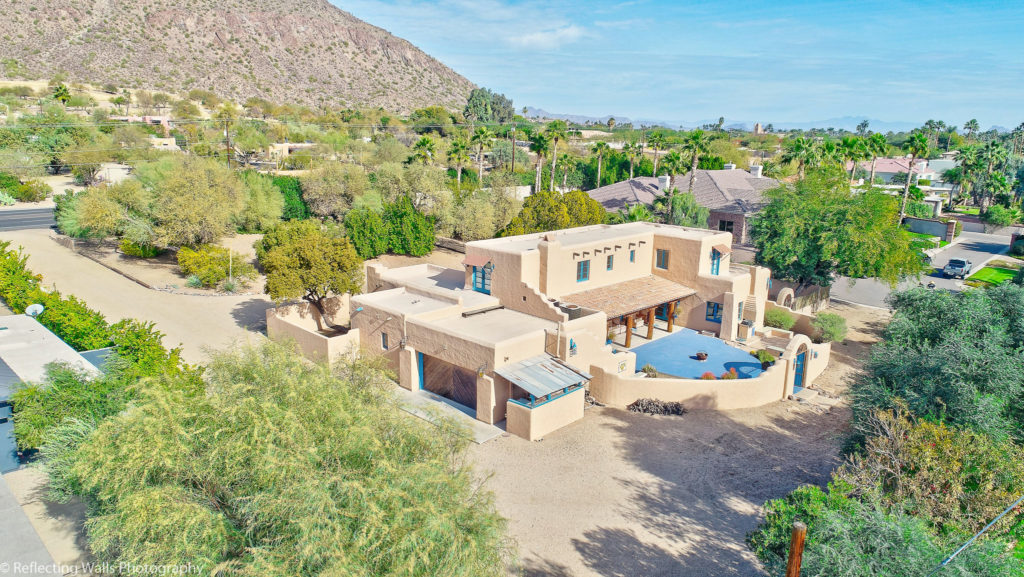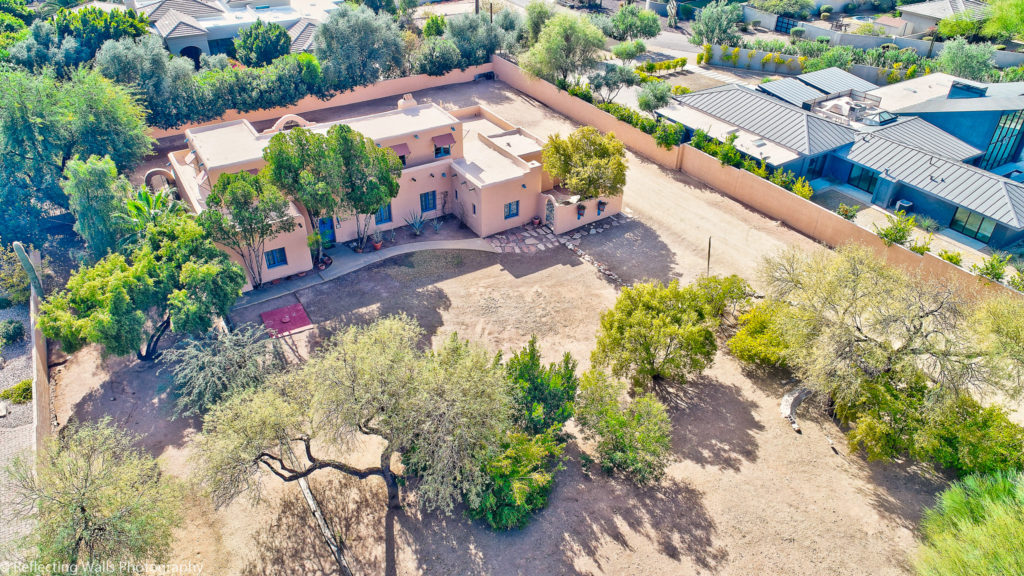The History of the Arcadia Neighborhood In Phoenix, Arizona
History of the Arcadia Neighborhood In Phoenix, AZ is very old and rich! In the 1920’s, land south of Camelback Mountain sold at 35 cents an acre.
What Does “Arcadia” Mean?
The name “Arcadia” is rooted in ancient Greek history. It is a region and also part of its mythology. Arcadia was home to one of the Greek gods and symbolizes “unspoiled, harmonious wilderness.” Aptly named, Arcadia in Phoenix in the 85018 Zip Code, Arizona is truly in harmony with nature. There’s majestic Camelback Mountain views. Water weaving in and out from the Arizona Canal. And an abundance of fruit trees.
Arcadia Real Estate In Phoenix Is More Than A Century Old
Arcadia has been considered valuable Phoenix real estate for more than a century. It all began in 1899 with the very first citrus grove. Planted in Arcadia, it performed exceptionally well in the fertile soil at the foot of the mountain. It didn’t take long before the area was teeming with citrus trees. The profitable crop attracted the eye of farmers, investors and land speculators. And it quickly became an important piece of the local economy.
35 Cents Per Acre
In the early 1920’s, the land to the south of majestic Camelback Mountain went up for sale at 35 cents an acre. It was mostly sold in 5-acre parcels as citrus orchards – that is, after the Arcadia Water Company began irrigating. Today, Arcadia residents enjoy a well-meshed neighborhood of spacious, architecturally interesting homes and the lush remnants of the area’s rural past.
Real Estate Planned for the Wealthy
With the implementation of the Salt River Valley Reclamation Project after the turn of the century, development of irrigable lands in the suburbs of Phoenix as large, rural homesites became a viable alternative land use. Single, independent construction efforts by some wealthy landowners were not uncommon. An Alternative and more ambitious concept was the development of large tracts of land, specifically for the purpose of creating upper class, rural estates suburbs.
The concept involved assembling sizable real estate holdings from several owners, then surveying, platting, and marketing the subdivision. Because assembling the necessary real estate in the Valley’s relatively mature agricultural environment was difficult, only one such subdivision emerged in the central Salt River Valley: the Arcadia Subdivision.
Original Location Boundaries of Arcadia
The part of Phoenix commonly referred to as Arcadia, encompasses the area north of the Arizona Canal and south of Camelback Road between 44th St. and Scottsdale Road. However, the first tract of land platted within this land area was not the original Arcadia development, but rather a development called Citrus Homes. First recorded in June 1915 by L.E. Froman, Citrus Homes was bounded by Camelback Road and Lafayette Blvd. to the North, 56th Street to the East, and the Arizona Canal to the South.
The Citrus Homes development contained 25 lots which ran from North to South with the southern boundary of each lot bordering on the Arizona Canal.
The First Recorded Development In Arcadia Phoenix
Located directly North and Northeast of the Citrus Homes development was the original Arcadia development first recorded in December 1919. Developed by the Jordan, Grace and Phelps Land Company and the Charles Keafer firm, Arcadia was bounded by Lafayette Blvd. to the south, Scottsdale Road to the east, approximately Rockridge Road to the north, and 44th Street to the west. The physical layout of the plat was divided into two distinct sections.
56th Street
First, the area east of 56th Street was divided into 23 blocks with each block further divided into 4 lots of approximately ten acres. Second, the area west of 56th Street was divided into 18 blocks with the majority of the blocks further divided into 8 lots of approximately five acres. One distinct feature of this plat was the designation of Block L, located north of Camelback Road and west of 56th Street, as the Arcadia Townsite.
Arcadia Tract Division
By dividing the Arcadia Tract into relatively large five to ten acre lots and mandating that no home could be constructed for less than $5,000, the developers were clearly attempting to attract the more affluent homeowner who wanted to live in a rural setting. In effect, these large lots were designed to be sold as small citrus orchards.
To this end, Arcadia’s developers, including Seymour Jordan, Robert Grace, and Charles Keafer, highlighted the area’s agricultural potential and hoped that “the purchasers of this land will engage in the growing of citrus fruits.”
The Birth of The Arcadia Water Company
In order to successfully develop citrus groves in Arcadia, there had to be a stable source of water from which the orchards could be irrigated. While Arcadia was located near the Arizona Canal because of the slope of the land only the lots south of Camelback Road benefited from the water source. Therefore, the developers, led by Seymour Jordan, formed the Arcadia Water Company in 1919. This organization constructed several large pumping plants in Paradise Valley capable of supplying 2,100 acres with water.
Transporting Water
In order to transport this water throughout the Arcadia development, an underground irrigation system was planned. By 1924, construction crews had laid fifteen miles of underground concrete pipe in the area. The dwelling which is currently the Shemer Art Center and Museum was built in 1919 as a residence for the foreman of the water company.
The original financing for the Arcadia plat had fallen through by the mid-1920’s, resulting in much of the area being refinanced and replatted by a variety of different owners between 1925 and 1031.
These subdivisions included Glencoe Highlands (1925), Arcadia Estates (1926), Arcadia Replatted (1926), Hacienda Allenada (1930), and Alta Hacienda (1931). Although Arcadia was no longer under single ownership.
An Affluent Community
For the most part the new developers still promoted “Arcadia” as a community for affluent people looking for a rural, estate atmosphere. Not only did lot size remain relatively large, ranging from 4 to 10 acres, but minimum cost restrictions for the construction of homes increased. Additionally, the agricultural potential of the area, particularly the cultivation of citrus groves, continued to be a priority.
Arcadia Replat Mandates
There existed several stated requirements concerning house construction in the Arcadia Replat. First, the cost of building a house had to exceed $10,000. This was an increase from a minimum outlay of $5,000 in the 1919 Arcadia Plat. The cost requirement was implemented in order to attract only the most wealthy investors and thereby create an exclusive community. A second requirement for construction concerned wood buildings.
All wood buildings had to be stained or painted immediately upon construction. Additionally, in an effort to establish continuity of appearance among houses, all new houses were required to “conform and harmonize with the type and exterior design of neighboring buildings within Arcadia Replatted.”
Mrs. Cotton’s House
One of the charming older homes located on the west side of the Central Arcadia area was built by Mrs. Jane Cotton around 1919 or 1924. A later owner had been told the house was built in 1924, but when cement work for the porch was done, a 1919 edition of a newspaper was found in a brick, leading the owners to believe that it could have been built then. The house is constructed of brick with hardwood floors, and it also has a basement. When Mrs. Cotton first lived in the home wild horses could be seen running along Lafayette Boulevard and indeed had the right of way.
The Ruth Wendell House
On the southwest corner of Lafayette and Avenida del Puente is a home built in 1935 for Ruth Wendell, who was the original founder of the Phoenix Crippled Children’s Hospital. Ms. Wendell was a school nurse from the Globe-Miami area. When she moved to Phoenix, she was concerned for the crippled Indian and Mexican children and began caring for them.
The parents of the children she helped wanted to build a house for her. The lot she purchased extended from Lafayette Boulevard south to the canal. The home had cement tile floors, and was made from adobe bricks that were made on the property. When they were working on the house, an Indian put a piece of bread in the wet frame of the doorway. He told Miss Wendell that, “Whoever entered the house would never go away hungry.”
The Cook Mansion
The 1930’s also saw the first of the resorts that have graced the district, attracted by the affluent, relaxed residential character of the area as it developed. The Cook Mansion, built by the Thomas Cook Travel Agency family, was converted at that time for this purpose and became the original structure for the Royal Palms Inn. Others developed in the early years in the area were the Jokake Inn, the Paradise Inn, and Elizabeth Arden’s Main Chance retreat, adding to the ambiance of the area.
In the mid 1950’s, Phoenix growth reached Arcadia. Although most of Arcadia is now in Phoenix, the area east of 64th Street is in Scottsdale.
The original Arcadia neighborhoods include:
- Citrus Homes
- Glencoe Highlands
- Arcadia Estates
- Arcadia Replatted
- Hacienda Allenada
- Alta Hacienda
Arcadia’s First Resorts
Further supporting the prosperous area, Arcadia saw its first resorts in 1930. It was now a destination in addition to an affluent community. The Cook Mansion, a 3,500-square foot Spanish-style villa on a sprawling 65 acres, turned into the modern-day Royal Palms Inn. It was a celebrity-hideaway favorite.
Pre-Phoenician
The Jokake Inn and Paradise Inn were other early developments. The properties were located on what’s now known as The Phoenician. Elizabeth Arden’s Maine Chance retreat was the first luxury spa. Inspired by Arden’s rural farm in Maine, the resort was open during winter months and quickly became a hot spot for First Ladies and other famous women.
History of the Arcadia Original Zoning Limitations
Zoning originally limited development to one house per five acres. Large setbacks were provided around the periphery of the five acre parcels. By the mid 1950’s, a number of residential developments had begun. One example is the Mountgrove area, formerly the Sphinx Date Ranch, extending from 46th Place to 47th Place and from the Arizona Canal north to Lafayette Boulevard. The majority of the homes were built in 1954 with careful attention to preserving the Sphinx Date palms, since it was believed that this was the only area in the United States where this variety would grow.
The Formation of the Mountgrove Property Owners Association
To watch for violation of zoning restrictions, the Mountgrove Property Owners Association was quickly formed and a declaration of restrictions was prepared and registered. There was strong feeling of keeping the area residential and, in 1960, the association successfully concluded a lengthy objection to commercial zoning of the date processing plant area on Lafayette between 46th Place and 47th Street.
1950s Arcadia: Phoenix Population Boom Reaches Camelback Mountain
Air-conditioning was now ubiquitous. And like that, Phoenix quickly became the largest city in the Southwest and one of the top 100 most populous cities in the US.
Arcadia’s home-building skyrocketed. Many of the area’s famous ranch-style homes were built during this time and complemented the larger estates. The mid-century homes were carefully constructed and also careful not to disrupt another important regional crop of the Sphinx Date Palm which was one of the few locations it would grow. The area became dotted with citrus and palm trees, making it a one-of-a-kind paradise complete with dramatic, romantic and breathtaking mountain views.
The quality of construction in the late 50’s and early 60’s in Arcadia has influenced many people in the area to renovate their homes rather than relocate to newer areas. Home values have steadily increased and the few remaining parcels in the neighborhood have been developed with high quality homes.
Resorts In Arcadia’s Phoenix Neighborhood
In the late 1980’s the Phoenician Resort located at 60th Street on the north side of Camelback Road was developed. With its 27 hole golf course and luxurious guest accommodation, it has gained international recognition as a 5-star resort.
Royal Palms Inn Renovation
The old Royal Palms Inn has also been renovated with unprecedented elegance. Its location is on the north side of Camelback Road at Rubicon Drive. Two new residential subdivisions have been developed in the 1990’s. Arcadia Estates is located at the southeast corner of Arcadia Drive and Lafayette Boulevard. Royal Palms Estates is developed on what once was the Royal Palms Inn executive golf course.
A 1926 Pueblo Revival Adobe Construction home also known as the Dr. Charles C. Bradbury House
Current Day High Demand
The area remains in demand because of the unique irrigation system, citrus groves, a quality school system, a strong and active neighborhood association, proximity to neighboring communities and relatively easy access to downtown Phoenix. The natural boundaries of the Arizona Canal on the south and Camelback Mountain on the north have kept the area quiet and insulated from traffic. These advantages are attracting many young families to the area.
Arcadia Schools
There are two elementary schools in the area: The Arcadia Neighborhood Learning Center at 4330 N. 62nd Street and Hopi Elementary School at 5510 E. Lafayette Blvd.
Herberger Park
There is one public recreation area known as Herberger Park at 56th Street and North of Indian School Road. This park has picnic tables and tennis courts.
Upscale Retail Shopping
Most of the retail is located at 44th Street and Camelback Road, and between 44th and 48th Street and Indian School Road. Scottsdale Fashion Square Mall is just a little bit north for some of the best retail shopping in the Valley. And, the upscale Biltmore Shopping Center is just a little bit south at Camelback and 24th St.
Phoenician Resort
The largest employer in the area is the Phoenician Resort with a staff of more than 1000 employees. The location of this resort is in the vicinity of 62nd Street and Camelback Road. The second largest employer is the Royal Palms Inn with 135 employees. The location of the recently renovated Royal Palms Inn is at the intersection of Rubicon Avenue and Camelback Road.
The closest police and fire facilities are located outside the special planning district. The Squaw Peak Precinct is located at 6206 North 24th Street. The nearest fire station is located at 4247 North 32nd Street.
Information In Part Courtesy of: Arcadia Camelback Special Planning District Final City Counsel Adoption June 16th, 1999; CNNMoney;
City of Phoenix Planning Department 200 West Washington Street Phoenix, AZ 85003


